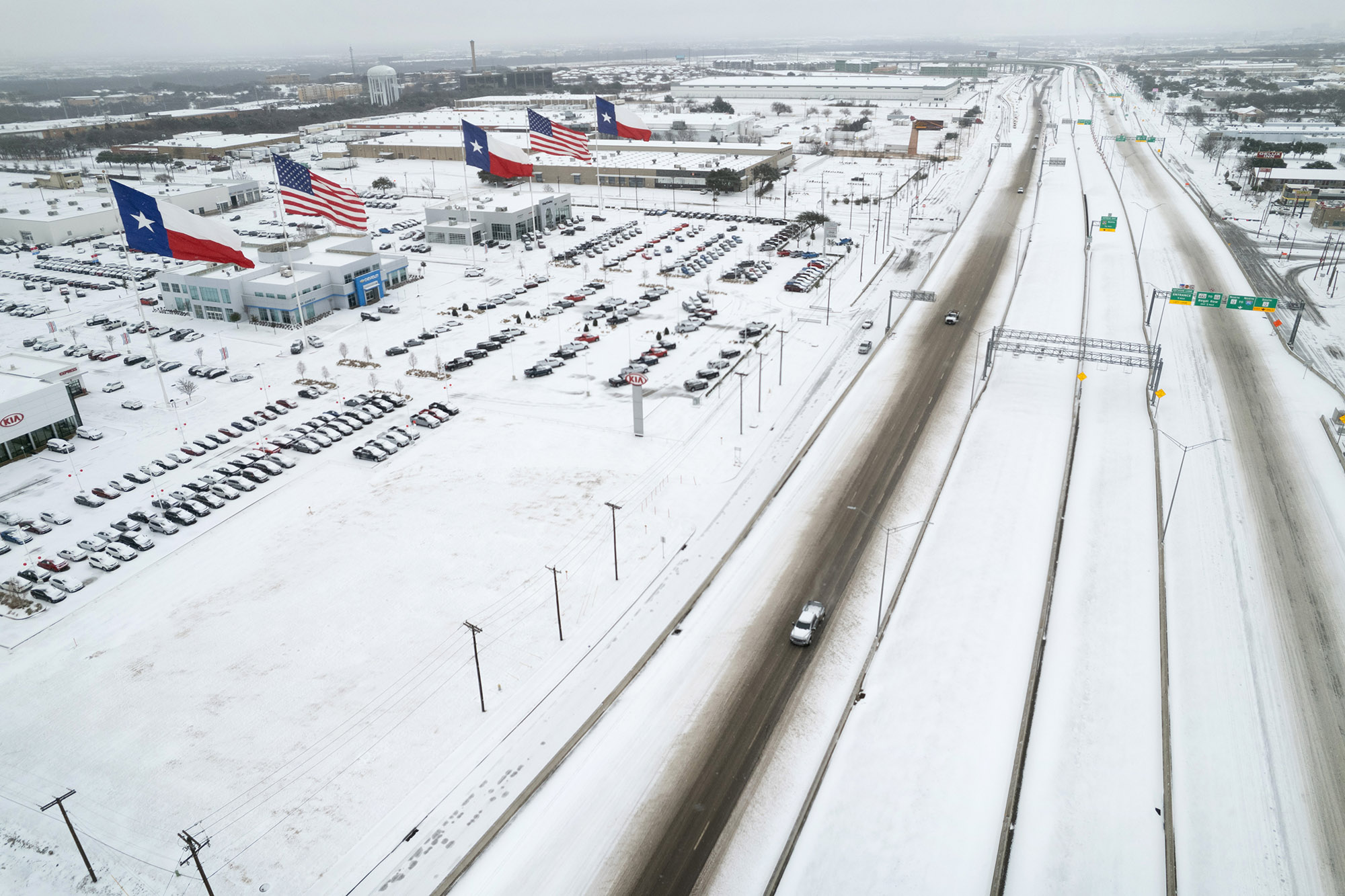Texas Grid Passes Winter Test but Critics Say It’s Still Fragile
(Bloomberg) -- Texas power grid passed its biggest test since last years deadly blackouts, keeping most lights on during a wintry blast. This storm, however, was far less severe than last years monstrous one, leaving questions whether the state is really ready for another deep freeze.
While reforms politicians enacted in the past year did help keep power plants running, analysts and power-market experts say the biggest reason things went so smoothly was it simply wasn't as cold for as long. That meant natural gas kept flowing and wind turbines worked far better, helping the grid meet the increased power demand as millions of Texans cranked up electric heaters.
 Traffic moves through snow and ice on U.S. Route 183 in Irving, Texas on Feb. 3.Photographer: John Moore/Getty Images
Traffic moves through snow and ice on U.S. Route 183 in Irving, Texas on Feb. 3.Photographer: John Moore/Getty Images
The grid held up fine for a couple of reasons: the weather wasn't as bad as we thought, and wind overperformed, said Michael Webber, an energy professor at the University of Texas. The demand wasn't as high, and the supply wasn't as low.
Texas Governor Greg Abbott and lawmakers can claim victory in averting major blackouts this time, even as experts say its unclear whether the states grid actually is ready to withstand a cold blast like the 2021 storm, which left more than 200 people dead. That has significant political implications.
Abbott, a Republican, has been promising the lights will stay on this winter, a crucial pledge in his re-election bid. The primary race is less than a month away, and Abbott appears to have a wide enough lead over his Republican challengers that he can avoid a runoff.
This helps him maintain that lead,Jennifer Danley-Scott, a lecturer at Texas Women University, said in an interview.
The governor pointed to measures taken since last years catastrophe including requiring power plants to winterize, a 15% increase in generation supplies over last year and availability of alternative fuels at generator facilities.
Critics, however, say those rules didnt do enough to ensure the states gas network -- the power grids lifeblood -- doesnt freeze up again. Gas flowed freely during this weeks storm, but thats largely because it didnt get cold enough.
The state still remains vulnerable because we have not set requirements for winterization of the gas system, said Webber, who is also chief technology officer at venture fund Energy Impact Partners. As such, the reliability of gas production is still flimsy.
Milder Storm
In Dallas, last years temperatures fell as low as -2 Fahrenheit (-19 Celsius), and there were 11 straight days with highs below 40 degrees. This year, forecast lows are around 10 degrees, and meteorologists expect just three consecutive days with highs below 40.
In Midland, the hub of the oil- and natural gas-rich Permian Basin, last year saw eight consecutive days when temperatures never rose above freezing, which crippled the flow of gas and starved power plants of fuel. This time, Midland didn't have back-to-back days when the mercury stayed below 32 degrees.
The last one was both longer and more extreme, said Marc Chenard, a meteorologist at the U.S. Weather Prediction Center.
While Ercot didn't ask consumers to conserve, widespread closures of schools and businesses helped cut down on consumption. Peak demand for electricity was significantly lower and a bit later than anticipated Friday morning, with consumption hitting 69 gigawatts when Ercot previously projected record demand of 75.6 gigawatts. A gigawatt is enough to power about 200,000 Texan homes.
More Reserves
Ercot also has been maintaining a lot more reserves ready to kick in at any signs of stress. At times, spare supplies were double or triple the 3,000 megawatts the grid operator regularly maintains. Plants were turned on even before they were needed so they would stay warm -- thanks to insulation and other weatherization now mandated -- even when temperatures dropped.
Supplies of natural gas, the main fuel for Texas power plants, also fared better. The 2021 disaster removed as much as 7 billion cubic feet of daily gas supplies in the state, according to industry figures. That was more than three times the losses incurred during this weeks chill, according to BloombergNEF data. Moreover, in last years event the states gas output remained strained for almost two weeks.
Wind also played a key role, bolstering power supply through the storm.
Last year it was at zero -- that is a ton of difference, Sean Kelly, co-founder of Amperon Holdings Inc., which provides analysis to utilities and power traders. It s definitely a big win for renewables and its definitely a big win for weatherization of wind farms.
More stories like this are available on bloomberg.com
©2022 Bloomberg L.P.
KEEPING THE ENERGY INDUSTRY CONNECTED
Subscribe to our newsletter and get the best of Energy Connects directly to your inbox each week.
By subscribing, you agree to the processing of your personal data by dmg events as described in the Privacy Policy.
More utilities news

Canada to End 30% Stake Limit to Boost Pension Fund Investment

Turkey’s Aydem Group Plans 2025 IPOs for Power Grid Operators

Germany’s Record-Beating Stocks Head for Further Gains in 2025

Equinor takes FID on UK’s first carbon capture projects at Teesside

BMW, Mercedes Add New Executives as Carmakers Tackle Crisis

Thames Water CEO Steers Away From Break Up After Covalis Bid

Germany Expecting Tight Power Conditions as Wind Output Falls

Nuclear Power Not Cost-Effective in Australia, Science Body Says

Vancouver Mayor Proposes Using Bitcoin in City Finances
















